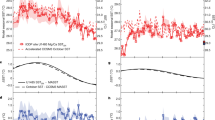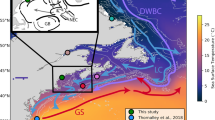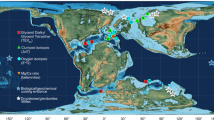Abstract
The early Eocene (49–55 million years ago) is a time interval characterized by elevated surface temperatures and atmospheric CO2 (refs 1,2), and a flatter-than-present latitudinal surface temperature gradient3,4. The multi-proxy-derived flat temperature gradient has been a challenge to reproduce in model simulations5,6,7, especially the subtropical warmth at the high-latitude surface oceans4,8, inferred from the archaeal lipid-based palaeothermometry,  . Here we revisit the
. Here we revisit the  interpretation by analysing a global collection of multi-proxy temperature estimates from sediment cores spanning millennia to millions of years. Comparing the variability between proxy types, we demonstrate that the present
interpretation by analysing a global collection of multi-proxy temperature estimates from sediment cores spanning millennia to millions of years. Comparing the variability between proxy types, we demonstrate that the present  interpretation9 overestimates the magnitude of past climate changes on all timescales. We attribute this to an inappropriate calibration, which reflects subsurface ocean but is calibrated to the sea surface, where the latitudinal temperature gradient is steeper. Recalibrating the proxy to the temperatures of subsurface ocean, where the signal is probably formed, yields colder
interpretation9 overestimates the magnitude of past climate changes on all timescales. We attribute this to an inappropriate calibration, which reflects subsurface ocean but is calibrated to the sea surface, where the latitudinal temperature gradient is steeper. Recalibrating the proxy to the temperatures of subsurface ocean, where the signal is probably formed, yields colder  -temperatures and latitudinal gradient consistent with standard climate model simulations of the Eocene climate10, invalidating the apparent, extremely warm polar sea surface temperatures. We conclude that there is a need to reinterpret
-temperatures and latitudinal gradient consistent with standard climate model simulations of the Eocene climate10, invalidating the apparent, extremely warm polar sea surface temperatures. We conclude that there is a need to reinterpret  -inferred marine temperature records in the literature, especially for reconstructions of past warm climates that rely heavily on this proxy as reflecting subsurface ocean.
-inferred marine temperature records in the literature, especially for reconstructions of past warm climates that rely heavily on this proxy as reflecting subsurface ocean.
This is a preview of subscription content, access via your institution
Access options
Subscribe to this journal
Receive 12 print issues and online access
$259.00 per year
only $21.58 per issue
Buy this article
- Purchase on Springer Link
- Instant access to full article PDF
Prices may be subject to local taxes which are calculated during checkout
 - and
- and  -inferred temperature variability.
-inferred temperature variability.
 calibration.
calibration.

Similar content being viewed by others
References
Zachos, J., Pagani, M., Sloan, L., Thomas, E. & Billups, K. Trends, rhythms, and aberrations in global climate 65 Ma to present. Science 292, 686–693 (2001).
Pagani, M., Zachos, J. C., Freeman, K. H., Tipple, B. & Bohaty, S. Marked decline in atmospheric carbon dioxide concentrations during the Paleogene. Science 309, 600–603 (2005).
Greenwood, D. R. & Wing, S. L. Eocene continental climates and latitudinal temperature gradients. Geology 23, 1044–1048 (1995).
Bijl, P. K. et al. Early Palaeogene temperature evolution of the southwest Pacific Ocean. Nature 461, 776–779 (2009).
Lunt, D. J. et al. A model–data comparison for a multi-model ensemble of early Eocene atmosphere–ocean simulations: EoMIP. Clim. Past 8, 1717–1736 (2012).
Huber, M. & Caballero, R. The early Eocene equable climate problem revisited. Clim. Past 7, 603–633 (2011).
Sagoo, N., Valdes, P., Flecker, R. & Gregoire, L. J. The early Eocene equable climate problem: can perturbations of climate model parameters identify possible solutions? Phil. Trans. R. Soc. A 371, 20130123 (2013).
Sluijs, A. et al. Subtropical Arctic Ocean temperatures during the Palaeocene/Eocene Thermal Maximum. Nature 441, 610–613 (2006).
Kim, J.-H. et al. New indices and calibrations derived from the distribution of crenarchaeal isoprenoid tetraether lipids: implications for past sea surface temperature reconstructions. Geochim. Cosmochim. Acta 74, 4639–4654 (2010).
Heinemann, M., Jungclaus, J. H. & Marotzke, J. Warm Paleocene/Eocene climate as simulated in ECHAM5/MPI-OM. Clim. Past 5, 785–802 (2009).
Pearson, A. & Ingalls, A. E. Assessing the use of archaeal lipids as marine environmental proxies. Annu. Rev. Earth Planet. Sci. 41, 359–384 (2013).
Schouten, S., Hopmans, E. C. & Sinninghe Damsté, J. S. The organic geochemistry of glycerol dialkyl glycerol tetraether lipids: a review. Org. Geochem. 54, 19–61 (2013).
Sluijs, A. et al. Southern ocean warming, sea level and hydrological change during the Paleocene–Eocene thermal maximum. Clim. Past 7, 47–61 (2011).
Pross, J. et al. Persistent near-tropical warmth on the Antarctic continent during the early Eocene epoch. Nature 488, 73–77 (2012).
Schouten, S., Hopmans, E. C., Schefuß, E. & Sinninghe Damsté, J. S. Distributional variations in marine crenarchaeotal membrane lipids: a new tool for reconstructing ancient sea water temperatures? Earth Planet. Sci. Lett. 204, 265–274 (2002).
Schouten, S., Forster, A., Panoto, F. E. & Sinninghe Damsté, J. S. Towards calibration of the TEX86 palaeothermometer for tropical sea surface temperatures in ancient greenhouse worlds. Org. Geochem. 38, 1537–1546 (2007).
O’ Brien, C. L. et al. High sea surface temperatures in tropical warm pools during the Pliocene. Nature Geosci. 7, 606–611 (2014).
Ho, S. L. & Laepple, T. Glacial cooling as inferred from marine temperature proxies and . Earth Planet. Sci. Lett. 409, 15–22 (2015).
Seki, O. et al. Assessment and calibration of TEX86 paleothermometry in the Sea of Okhotsk and sub-polar North Pacific region: implications for paleoceanography. Prog. Oceanogr. 126, 254–266 (2014).
Kim, J.-H. et al. Pronounced subsurface cooling of North Atlantic waters off northwest Africa during Dansgaard–Oeschger interstadials. Earth Planet. Sci. Lett. 339–340, 95–102 (2012).
Ohkouchi, N., Eglinton, T. I., Keigwin, L. D. & Hayes, J. M. Spatial and temporal offsets between proxy records in a sediment drift. Science 298, 1224–1227 (2002).
Rhines, A. & Huybers, P. Estimation of spectral power laws in time uncertain series of data with application to the Greenland Ice Sheet Project 2 δ18O record. J. Geophys. Res. Atmos. 116, D01103 (2011).
Laepple, T. & Huybers, P. Reconciling discrepancies between Uk37 and Mg/Ca reconstructions of Holocene marine temperature variability. Earth Planet. Sci. Lett. 375, 418–429 (2013).
Laepple, T. & Huybers, P. Ocean surface temperature variability: large model–data differences at decadal and longer periods. Proc. Natl Acad. Sci. USA 111, 16682–16687 (2014).
Qin, W. et al. Confounding effects of oxygen and temperature on the TEX86 signature of marine Thaumarchaeota. Proc. Natl Acad. Sci. USA 112, 10979–10984 (2015).
Conte, M. H. et al. Global temperature calibration of the alkenone unsaturation index ( ) in surface waters and comparison with surface sediments. Geochem. Geophys. Geosyst. 7, Q02005 (2006).
Karner, M. B., DeLong, E. F. & Karl, D. M. Archaeal dominance in the mesopelagic zone of the Pacific Ocean. Nature 409, 507–510 (2001).
Merbt, S. N. et al. Differential photoinhibition of bacterial and archaeal ammonia oxidation. FEMS Microbiol. Lett. 327, 41–46 (2012).
Taylor, K. W. R., Huber, M., Hollis, C. J., Hernandez-Sanchez, M. T. & Pancost, R. D. Re-evaluating modern and Palaeogene GDGT distributions: implications for SST reconstructions. Glob. Planet. Change 108, 158–174 (2013).
Thomas, D. J., Bralower, T. J. & Jones, C. E. Neodymium isotopic reconstruction of late Paleocene–early Eocene thermohaline circulation. Earth Planet. Sci. Lett. 209, 309–322 (2003).
Müller, P. J., Kirst, G., Ruhland, G., von Storch, I. & Rosell-Melé, A. Calibration of the alkenone paleotemperature index based on core-tops from the eastern South Atlantic and the global ocean (60° N–60° S). Geochim. Cosmochim. Acta 62, 1757–1772 (1998).
Percival, D. B. & Walden, A. T. Spectral Analysis for Physical Applications: Multitaper and Conventional Univariate Techniques (Cambridge Univ. Press, 1993).
McClymont, E. L. et al. Sea-surface temperature records of Termination 1 in the Gulf of California: challenges for seasonal and interannual analogues of tropical Pacific climate change. Paleoceanography 27, PA2202 (2012).
Richey, J. N., Hollander, D. J., Flower, B. P. & Eglinton, T. I. Merging late Holocene molecular organic and foraminiferal-based geochemical records of sea surface temperature in the Gulf of Mexico. Paleoceanography 26, PA1209 (2011).
Prahl, F. G., Muehlhausen, L. A. & Zahnle, D. L. Further evaluation of long-chain alkenones as indicators of paleoceanographic conditions. Geochim. Cosmochim. Acta 52, 2303–2310 (1988).
Tierney, J. E. & Tingley, M. P. A Bayesian, spatially-varying calibration model for the TEX86 proxy. Geochim. Cosmochim. Acta 127, 83–106 (2014).
Locarnini, R. A. et al. NOAA Atlas NESDIS 68 184 (US Government Printing Office, 2010).
Steiger, J. H. Test for comparing elements of a correlation matrix. Psychol. Bull. 87, 245–251 (1980).
Bijl, P. K. et al. Eocene cooling linked to early flow across the Tasmanian Gateway. Proc. Natl Acad. Sci. USA 110, 9645–9650 (2013).
Frieling, J. et al. Paleocene–Eocene warming and biotic response in the epicontinental West Siberian Sea. Geology 42, 767–770 (2014).
van Hinsbergen, D. J. J. et al. A paleolatitude calculator for paleoclimate studies. PLoS ONE 10, e0126946 (2015).
Torsvik, T. H. et al. Phanerozoic polar wander, palaeogeography and dynamics. Earth-Sci. Rev. 114, 325–368 (2012).
Bemis, B. E., Spero, H. J., Bijma, J. & Lea, D. W. Reevaluation of the oxygen isotopic composition of planktonic foraminifera: experimental results and revised paleotemperature equations. Paleoceanography 13, 150–160 (1998).
Anand, P., Elderfield, H. & Conte, M. H. Calibration of Mg/Ca thermometry in planktonic foraminifera from a sediment trap time series. Paleoceanography 18, 1050 (2003).
Ghosh, P. et al. 13C–18O bonds in carbonate minerals: a new kind of paleothermometer. Geochim. Cosmochim. Acta 70, 1439–1456 (2006).
Pearson, P. N. et al. Stable warm tropical climate through the Eocene epoch. Geology 35, 211–214 (2007).
John, C. M. et al. North American continental margin records of the Paleocene–Eocene thermal maximum: implications for global carbon and hydrological cycling. Paleoceanography 23, PA2217 (2008).
Zachos, J. C. et al. Extreme warming of mid-latitude coastal ocean during the Paleocene–Eocene Thermal Maximum: inferences from TEX86 and isotope data. Geology 34, 737–740 (2006).
Zachos, J. C., Dickens, G. R. & Zeebe, R. E. An early Cenozoic perspective on greenhouse warming and carbon-cycle dynamics. Nature 451, 279–283 (2008).
Dunkley Jones, T. et al. Climate model and proxy data constraints on ocean warming across the Paleocene–Eocene Thermal Maximum. Earth-Sci. Rev. 125, 123–145 (2013).
Weijers, J. W. H., Schouten, S., Spaargaren, O. C. & Sinninghe Damsté, J. S. Occurrence and distribution of tetraether membrane lipids in soils: implications for the use of the TEX86 proxy and the BIT index. Org. Geochem. 37, 1680–1693 (2006).
Liu, Z. et al. Global cooling during the Eocene–Oligocene climate transition. Science 323, 1187–1190 (2009).
Kim, J.-H. et al. Holocene subsurface temperature variability in the eastern Antarctic continental margin. Geophys. Res. Lett. 39, L06705 (2012).
Bice, K. L. & Marotzke, J. Numerical evidence against reversed thermohaline circulation in the warm Paleocene/Eocene ocean. J. Geophys. Res. Oceans 106, 11529–11542 (2001).
Acknowledgements
We thank M. Heinemann for providing the ECHAM5/MPI-OM Eocene simulation, and authors who shared their published data. We acknowledge the World Climate Research Programme’s Working Group on Coupled Modelling, which is responsible for CMIP, and we thank the climate modelling groups for producing and making available their model output. For CMIP, the US Department of Energy’s Program for Climate Model Diagnosis and Intercomparison provides coordinating support and led development of software infrastructure in partnership with the Global Organization for Earth System Science Portals. We thank D. Naafs, K. Rehfeld, P. Huybers, M. Heinemann, C. Huguet, G. Inglis and P. Bijl for fruitful discussions. J. Groeneveld, R. Tapia and G. Martinez-Mendez helped with the collection of Mg/Ca data. This work was supported by the Initiative and Networking Fund of the Helmholtz Association Grant VG-NH900.
Author information
Authors and Affiliations
Contributions
S.L.H. and T.L. contributed equally to the study.
Corresponding authors
Ethics declarations
Competing interests
The authors declare no competing financial interests.
Supplementary information
Supplementary Information
Supplementary Information (PDF 2535 kb)
Supplementary Information
Supplementary Information (XLSX 22 kb)
Rights and permissions
About this article
Cite this article
Ho, S., Laepple, T. Flat meridional temperature gradient in the early Eocene in the subsurface rather than surface ocean. Nature Geosci 9, 606–610 (2016). https://doi.org/10.1038/ngeo2763
Received:
Accepted:
Published:
Issue Date:
DOI: https://doi.org/10.1038/ngeo2763
This article is cited by
-
Coupled Southern Ocean cooling and Antarctic ice sheet expansion during the middle Miocene
Nature Geoscience (2020)
-
A late Pleistocene dataset of Agulhas Current variability
Scientific Data (2020)
-
Lipidomics in archaeal membrane adaptation to environmental stresses and growth conditions: A review of culture-based physiological studies
Science China Earth Sciences (2020)
-
Synchronous tropical and polar temperature evolution in the Eocene
Nature (2018)
-
High temperatures in the terrestrial mid-latitudes during the early Palaeogene
Nature Geoscience (2018)



